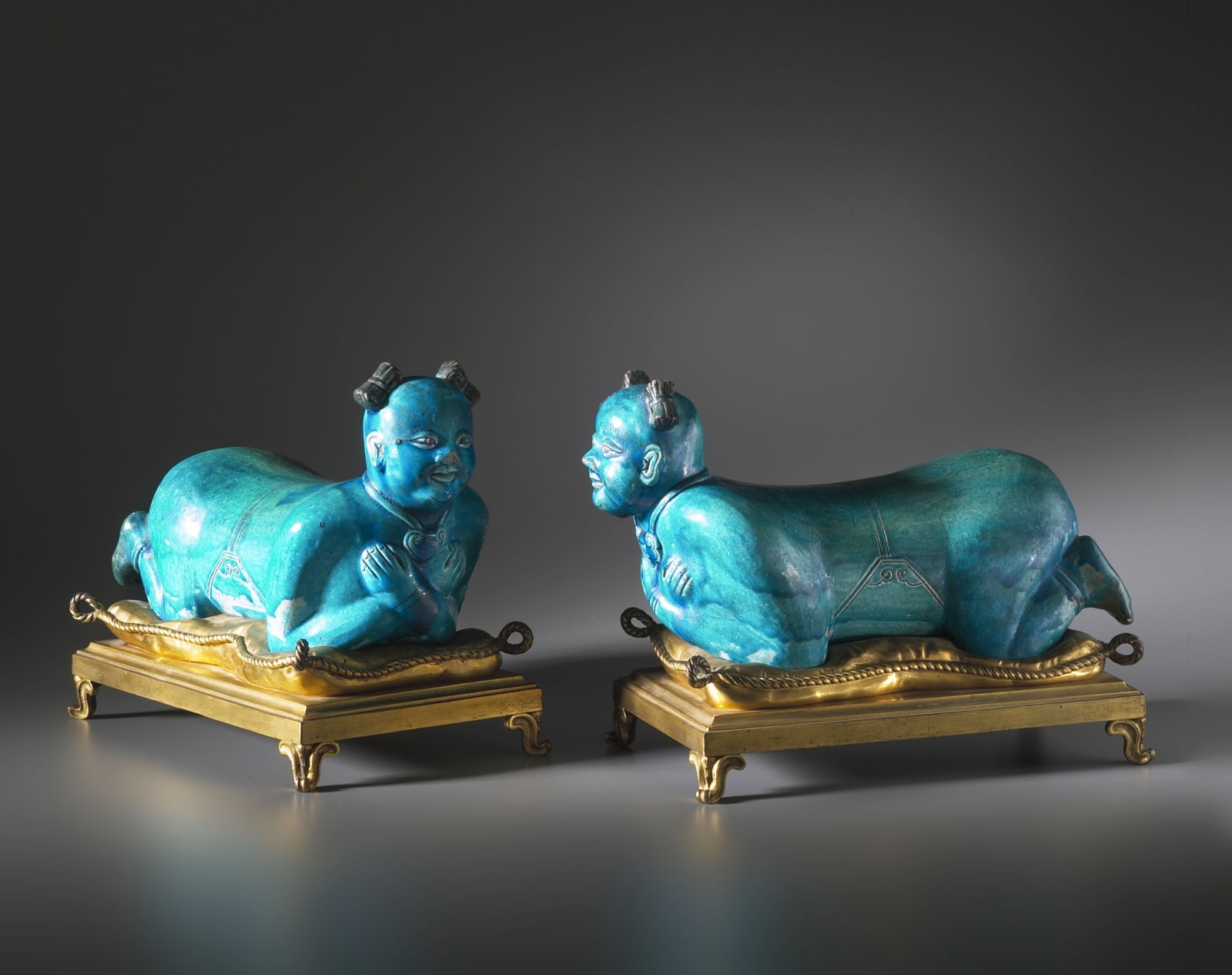Unknown
Literature
Wang-go Weng and Boda Yang, "The Palace Museum Peking, Treasures of the Forbidden City", 1982, pp. 92-93, pl. 15, illustrating an earlier but comparable Song Dynasty white glaze porcelaneous stoneware Zhen pillow in the form of a child on its belly in the Palace Museum Peking.
An extremely fine and important pair of gilt bronze mounted Chinese Ming Dynasty turquoise porcelain pillows marked on the under side, each formed as a young boy resting on all fours, with his arms crossed beneath his chest, his head held high, hair tied in two bunches and facial features finely and crisply executed, wearing a bib around his waist, a medallion around his neck and bangles around his ankles and wrists, each figure resting on a very fine gilt bronze cushion with a twisted cord around the edges and looped at each corner, on a rectangular base with scrolled feet
The porcelain pillows: Early seventeenth century, late Ming Dynasty.
The gilt bronze: French late eighteenth century or early nineteenth century.
Height 27.5 cm, length 39 cm, depth 20 cm. each.
These very fine Chinese porcelain pillows are of superb quality. They date to the early seventeenth century and thus belong to the late Ming period. The Ming Dynasty spanned three centuries from 1368-1644, during which times some of the greatest developments were made in the production of Chinese porcelain. The present works feature a wonderful turquoise glaze; also known as peacock-green or peacock-blue, it derived its colour from a copper oxide in an alkaline glaze mix. Turquoise glazes appeared intermittently in Chinese ceramics from as early as the Yuan period, however one of the best known examples is a fifteenth century Ming period large stoneware guan (wine jar), illustrated by R. E. Scott, "Imperial Taste: Chinese Ceramics from the Percival David Foundation", 1989, no. 36.
These porcelain pillows are not only very important but also present an interesting aspect of Chinese culture that appears to be something of an anomaly in modern Western terms since pillows are usually associated with soft materials. However the Chinese found porcelain pillows to be extremely comfortable. Summers in many parts of China were warm and humid and thus such pillows were considered a 'blessing' upon which one could rest the head or even ones hands. It is also noted that some pillows were also filled with hot water for use during the colder months of the year. The most ancient Chinese pillows were made of natural stone but later wood, jade, bronze, porcelain and bamboo was used in their construction. However porcelain proved the most desirable and most widely used material, which under the expertise of the potter's hands was modelled into a variety of shapes and forms.
Porcelain pillows were first made in the Sui Dynasty (581-618); greater numbers began to appear during the Tang Dynasty (618-907) but in terms of production they reached their apogee during the Song, Jin and Yuan Dynasties (tenth-fourteenth century). With the emergence of softer pillow-making materials production was gradually phased out in the Ming and Qing Dynasties (1368-1911), which makes this pair even more rare since less numbers were being made at this time.
In terms of the development of porcelain pillows, those made at the Cizhou Kiln in northern China during the Song Dynasty (960-1279) were the most representative and featured a wide variety of forms that included geometric and architectural shapes as well as animals and human figures. Many were ornamented with colourful decorative patterns and usually included motifs such as animals, plants, human figures, mountains and waters as well as Chinese characters. The modelling and decorative patterns on such pillows often directly or indirectly reflected the culture, customs, fashions, and social pursuits of the day.
Techniques in decorations varied in accordance with the different dynasties and areas of their production. Before the Tang and Five Dynasties (seventh-tenth century), porcelain pillows were mainly of moderate imprint and careful carving. During the Song and Jin period (tenth-thirteenth century), porcelain pillows featured paintings and more complicated decoration techniques. With further improvement of porcelain-making skills and decorative techniques, porcelain pillows demonstrated even greater heights.
An interesting aspect of the present pillows is the fact that they have been mounted at a later date and set upon a fine gilt bronze cushioned base. Judging from their style they probably date to the late eighteenth or early nineteenth century. This additional was almost certainly undertaken in Paris by one of the master bronziers of the day. Since they were first introduced into Europe during the fourteenth century, Chinese porcelains were regarded as objects of great rarity and luxury. Europe's fascination with such porcelain reached a peak during the eighteenth and nineteenth centuries and eager to display such works, they were often then adapted to include the finest gilt bronze mounts.
